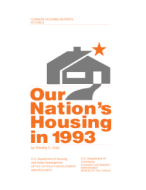
An official website of the United States government
Here’s how you know
Official websites use .gov
A .gov website belongs to an official government organization in the United States.
Secure .gov websites use HTTPS
A lock (
) or https:// means you’ve safely connected to the .gov website. Share sensitive information only on official, secure websites.
-
//
- Census.gov /
- Library /
- Publications /
- Our Nation's Housing in 1993
Our Nation's Housing in 1993
Our Nation's Housing in 1993
Highlights
Housing Inventory
- The housing inventory in 1993 consisted of 106.6 million units, an increase of 2 million units since 1991.
- Vacant units accounted for about 11 ±0.3 percent of housing in our country.
- The typical year-round vacant housing unit was only slightly older than the average occupied unit but was considerably smaller.
Characteristics for Owner-Occupied Housing Units
- Of the 94.7 million occupied units in the United States, 61.3 million (65 ±0.5 percent ) were owner-occupied.
- Men living alone have a lower homeownership rate than women, yet, among single parents, single mothers were far less likely than single fathers to be homeowners.
- Owner-occupied homes were most likely to be single-family homes, with a median age of 27 years, six rooms including three bedrooms, and 1,800 square feet of living area.
- About 86 ±0.4 percent of homeowners had the amenities of a clothes washer and dryer, telephone, and private transportation. Only about 5 ±0.3 percent of owners reported that their homes had physical problems, but 64 ±0.6 percent noted problems with their neighborhood.
- Median income for owners was $36,485 ±471 in 1993, with 9 ±0.3 percent categorized as low-income households.
- Homeowners with a mortgaged home spent a median of about $800 each month for housing, or 22 percent of their income. Owners living in homes already paid off spent less than a third as much, or $240 per month, consuming 14 percent of their income.
- The median value of owner-occupied housing was about $86,500, and annual property taxes amounted to some $950.
Characteristics for Renter-Occupied Housing Units
- For renters, the typical home was an apartment with four median rooms, including two bedrooms, in a building 29 years old.
- Only about one-third of renters (35 percent) had all the conveniences of a telephone and washer and dryer in their unit.
- Renters evaluated their homes and neighborhoods less favorably than homeowners. Higher proportions of renters also cited crime and noise as neighborhood problems.
- The median income for renters was $19,000, and one-quarter of all renters were low-income households.
- The median monthly housing cost for renters was $487. The typical renter allocated about 29 percent of family income for rent and utilities.
Share
Some content on this site is available in several different electronic formats. Some of the files may require a plug-in or additional software to view.
 Yes
Yes
 No
NoComments or suggestions?


Top

